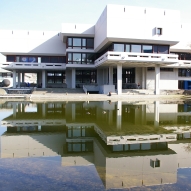| Dokumentenart: | Artikel | ||||
|---|---|---|---|---|---|
| Titel eines Journals oder einer Zeitschrift: | Inorganica Chimica Acta | ||||
| Band: | 357 | ||||
| Nummer des Zeitschriftenheftes oder des Kapitels: | 15 | ||||
| Seitenbereich: | S. 4452-4466 | ||||
| Datum: | 2004 | ||||
| Zusätzliche Informationen (Öffentlich): | CAN 142:126560 1-3 Pharmacology 792912-73-3P; 792912-74-4P; 792912-75-5P; 792912-77-7P; 827325-34-8P; 827325-35-9P; 827325-36-0P Role: PAC (Pharmacological activity), SPN (Synthetic preparation), THU (Therapeutic use), BIOL (Biological study), PREP (Preparation), USES (Uses) (carboplatin derivs. with superior antitumor activity compared to the parent compd.); 99038-34-3 Role: PAC (Pharmacological activity), THU (Therapeutic use), BIOL (Biological study), USES (Uses) (carboplatin derivs. with superior antitumor activity compared to the parent compd.); 5445-51-2 (1,1-Cyclobutanedicarboxylic acid); 15663-27-1 (Cisplatin); 38780-40-4; 41575-94-4; 52241-26-6; 99173-61-2; 123812-76-0; 123812-77-1; 161096-40-8; 792912-76-6 Role: RCT (Reactant), RACT (Reactant or reagent) (carboplatin derivs. with superior antitumor activity compared to the parent compd.); 35995-55-2P; 51816-01-4P (1,1-Cyclobutanedicarbonyl dichloride); 54166-15-3P; 89582-02-5P; 89639-43-0P; 99974-66-0P; 825620-41-5P; 827032-76-8P; 827032-77-9P; 827032-78-0P; 827032-79-1P; 827032-80-4P Role: RCT (Reactant), SPN (Synthetic preparation), PREP (Preparation), RACT (Reactant or reagent) (carboplatin derivs. with superior antitumor activity compared to the parent compd.) | ||||
| Institutionen: | Chemie und Pharmazie > Institut für Anorganische Chemie Chemie und Pharmazie > Institut für Pharmazie > Lehrstuhl Pharmazeutische / Medizinische Chemie II (Prof. Buschauer) | ||||
| Identifikationsnummer: |
| ||||
| Stichwörter / Keywords: | Antitumor agents; Bladder; Human; Structure-activity relationship (carboplatin derivs. with superior antitumor activity compared to the parent compd.); Ovary, neoplasm (cisplatin-resistant, carboplatin derivs. with superior antitumor activity compared to the parent compd.); carboplatin deriv prepn | ||||
| Dewey-Dezimal-Klassifikation: | 500 Naturwissenschaften und Mathematik > 570 Biowissenschaften, Biologie 500 Naturwissenschaften und Mathematik > 540 Chemie | ||||
| Status: | Veröffentlicht | ||||
| Begutachtet: | Ja, diese Version wurde begutachtet | ||||
| An der Universität Regensburg entstanden: | Ja | ||||
| Dokumenten-ID: | 5472 |
Zusammenfassung
A series of new carboplatin derivs. was synthesized by introducing fluoro, chloro, bromo and hydroxy substituents into the cyclobutane ring. The carboxylic acid groups were used for the complexation with platinum(II) fragments bearing two ammonia and (RR/SS)-trans-1,2-diaminocyclohexane ligands, resp., as non-leaving groups. The antiproliferative activity of the new carboplatin analogs differing ...

Zusammenfassung
A series of new carboplatin derivs. was synthesized by introducing fluoro, chloro, bromo and hydroxy substituents into the cyclobutane ring. The carboxylic acid groups were used for the complexation with platinum(II) fragments bearing two ammonia and (RR/SS)-trans-1,2-diaminocyclohexane ligands, resp., as non-leaving groups. The antiproliferative activity of the new carboplatin analogs differing in the cyclobutanedicarboxylato ligands and the type of platinum fragment were studied in tests with J82 bladder cancer cells and SK-OV-3 as well as cisplatin-resistant NIH:OVCAR-3 ovarian cancer cells. The most active compds. were the 3-fluoro, 3-chloro and 3,3-difluoro derivs. of carboplatin. NMR spectroscopy showed that cis-diammine(3-chloro-1,1-cyclobutanedicarboxylato)platinum(II) was hydrolyzed much faster than carboplatin explaining its higher cytostatic activity.
Metadaten zuletzt geändert: 24 Mai 2018 10:10



 Altmetric
Altmetric